Take a look at this. If this doesn't convince you to go organic, or at least grow your own produce sustainably, then I don't know what would!
Thursday 18 December 2008
Monsanto versus biodiversity
Tuesday 25 November 2008
Fertilizing beetroot
I've managed to thin out our beetroot crop now and we used the thinned out seedling leaves for salads in the process. Yummo!
The roots are forming nicely and we've covered with a layer of sugarcane mulch - so I'm wondering if a good fertilizing now would be worthwhile? I've been checking up on organic fertilizers, and so far the option seems to be a decent fertilizer 'tea'. This will work for us as we can use our worm wee as the basis for the tea - in fact it IS the tea! :o)
The best thing about growing beetroot is that it's so easy, as long as you prepare the soil and add some good compost. A bit of a water while they are seedlings helps them along and then a good deep watering every so often as they mature. They also love the sunshine. Here are some other tips for growing beetroot.
Anyhow, while checking out how others grow beetroot, I came across a site called 1stop Organic Gardening by Julie, based in the Barossa Valley in South Australia. She has one mean no-dig garden, I'll give her that! I've added this site to our 'Companion plantings' list to the right of your screen.
Julie also has a pickled beetroot recipe, which, once our beetroot are ready to harvest, we'll have a go at!
Great blog Julie, thank you for sharing you learning.
Posted by
Marg
at
Tuesday, November 25, 2008
0
comments
![]()
Labels: 2008, beetroot, compost, organic_fertilizer, organic_gardening, spring08
Thursday 20 November 2008
Singing in the rain
11.4mm of rain! Hooray!
Our plants say thank you :o)
Tuesday 18 November 2008
Spring rolls on into harvest-time
Harvested the garlic yesterday. 10 small to medium sized bulbs. They are better formed than last year's crop too. The soil in the Bed (i.e. bed #5) is a bit compacted now, and I wonder if this may have diminished the size of the garlic? Anyway, once the broad beans have finished in this bed, we can turn it over and build it up again with some more manure and mulch, etc.
The broad beans and carrots (a line of carrots in the pic above) have also been cropping well. I think we've had more rain this season than last year which has paid off.
The spring onion seed heads are now ready to store - I will put down a late crop now to see how they go as well. I've also let the chard go to seed too - hoping to store these and see if they'll produce for us too. We may need to build a small seed propagation area too, I'm thinking - that can be our next project :o)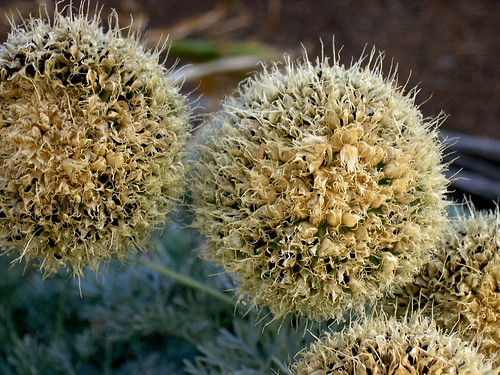
Planted a second lot of corn about 2 weeks ago, only a half dozen in a small area by the shed - they've come up quickly. The first lot of corn is about 20cm tall now and the purple beans I planted around them about 2 weeks ago have also taken off. The corn stalks make good support structures for the beans.
The beetroot I planted en-masse have been thinned - we used the small plants for their leaves in salads, rather than transplanting them. The remaining plants are now starting to form a root ball - the beet! I love beetroot :o)
Our new garden beds are proving their worth so far! Let's hope the corn and beans crop well to consolidate this! That also depends on how hot our Summer is this year - it's shaping up to be a hot one apparently. Fingers crossed!
Posted by
Marg
at
Tuesday, November 18, 2008
0
comments
![]()
Labels: 2008, beans, beetroot, broadbeans, carrots, corn, garlic, spring_onion, spring08, vegetables
Tuesday 21 October 2008
Vegetables and plantings for Spring 08
I've been meaning to post our plantings this season and just haven't had a chance to sit down and do so, ...so here goes!
We've made the most of our new garden beds and now seem to have more space for things too. Bed #1: Most recently planted chicory, raddichio and basil, pruned back the parsely and removed an old parsley bush. About to pull out old celery for composting and have let the chard go to seed for next planting.
Bed #1: Most recently planted chicory, raddichio and basil, pruned back the parsely and removed an old parsley bush. About to pull out old celery for composting and have let the chard go to seed for next planting.
Bed #2: Dwarf broadbeans are very healthy here and are starting to produce now - I just love the scent of their flowers too. Also in this bed are some potatoes - Desiree, which are already poking up through the soil. We've also moved some of the herbs here (sage, tarragon) to a sunnier spot (garden bed #3a).
Bed #3a (by the back gate, left of the shrub above in graphic): beetroot (2 rows) and cos lettuce, along with the abovementioned herbs.
Bed #3b + 4 (along the fence as shown by #3 above): more cos lettuce (as a border), 3 blueberry shrubs (1 early-season, 1 mid-season and 1 late-season variety), corn, snowpeas, galangal, lemongrass, golden and black zucchini, plus a couple of rogue tomato plants. This bed gets really good sun, but will need some attention when it really hots up!
Bed #5: More dwarf broadbeans, chard and celery, plus carrots (2 rows) and garlic. A Silverwood and recently sown yellow squash and patty pans. Also some lemon balm doing really well and some lemon thyme. There's a transplanted parsley bush here too (you can tell we love our parsley). After cutting back the bay tree, this bed gets much more sun and is producing well now. The garlic are almost ready to harvest too. We've also let some of our spring onions go to seed (much to the delight of our bee friends) and will save these for next season.
Our compost is doing really great too! We beefed it up with some cow poo and lots of green waste from our spring clean.
The citrus trees are growing well in the half wine barrels. The lemon has lots of flowers and the kaffir and Tahitian limes each have lots of new growth. I have lots of carrots around the kaffir lime as well - I wonder if this will impact the flavour at all - we'll soon see!
Simon pruned the passionfruit vines right back as well, ready for new summer growth - can't wait for those plump passionfruit to start dropping from the vine!
That's a quick rundown for now, will post as we harvest or as more news from the garden occurs (like our aphid moment!).
Posted by
Marg
at
Tuesday, October 21, 2008
0
comments
![]()
Labels: 2008, gardening_beds, plantings, spring2008, vegetables
Ladybird warriors
It's almost 2weeks since the aphid infestation on our plum trees, and there's been a marked improvement, helped by ants and those bespeckled garden companions, the ladybirds!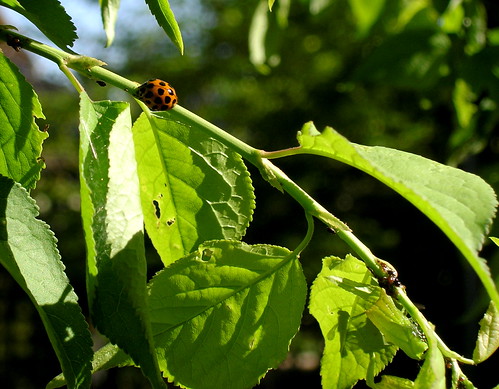
![]()
![]()
Jerry from Gardening Australia says: "Adults [ladybirds that is!] will consume 2,500 aphids during their life."
That's lucky for us! :o)
I've used the water and detergent solution three times in that time and it seems to had quite an effect - the trees now smell like fresh lemon!
Posted by
Marg
at
Tuesday, October 21, 2008
1 comments
![]()
Labels: aphids, home_remedies, ladybirds, orchard_trees, pests
Wednesday 15 October 2008
Aaaah! Aphids!
I'm a bad bad gardener!
A couple of weeks ago I noticed aphids on the little Hellebora that sits at our front doorstep and thought "hmmm, there's a lot of aphids on that plant, lucky they aren't going for our orchard trees or anything", then thought no more of it (as you do).
Then, Simon says, "I think there's aphids on the plum tree." I'm in denial. "Why would they be on the plum tree? Are you sure they're aphids?"
Sure enough, the poor plums were both covered brown with aphids!! Thank goodness for the Internet! :o) I searched for home remedies for aphids and came across this very practical website titled 'Getting Rid of Things' (including aphids). I noted the method and promptly emptied a pump spray bottle of detergent and lukewarm water over both our plum trees and Clancy's weeping apricot, all the while bemoaning my gardener neglect! More about aphids from the website:
called honeydew that often results in the colonization of an ugly sooty black fungus.
Aphids love new growth it seems (uh, duh!) and have a protective coating which deters birds and other predators from attacking them, especially when they clump in large numbers, as they tend to do. You can disperse them with a good jet of water, but our plum trees are so seriously covered that we'd empty a rainwater tank of water on them if we tried that way! :o)
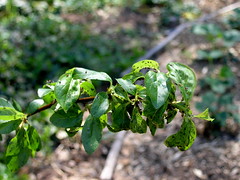
We will see how the detergent and water trick goes. It's supposed to remove the aphids' protective coating and leave them not only vulnerable to ladybirds, spiders and ants, but also dehydrated, so they die. Ladybirds are a great biological control for aphids. The site suggests some ways to encourage ladybirds into your garden.
Postscript: Day 3 after spraying and so far, so good. The aphid movement has dropped dramatically. Another dose of detergent and lukewarm water in a few days should see the aphids take flight altogether to another poor soul's garden!
Wednesday 1 October 2008
Slow food, calm learning
I've just started reading Barbara Kingsolver's Animal, Vegetable, Miracle: Our year of seasonal eating (2007) and I've been reading it out aloud to my daughter, Clancy, aged uh... 2 months (in the hope that she'll take it all in by osmosis). :o)
[Image source: Amazon]
It's a witty read that's for sure. Kingsolver rolls together her family's learnings and some pretty crazy stats and knowledge of the world at large when it comes to food production and consumption, at least in North America anyway.
Since having my daughter, I've been viewing the world in a different light - sort of a 'what if' lens that focused entirely on potential benefits for her! So, of course, given we've been gardening and learning about growing our own produce in our back yard in the suburbs of Canberra, I'm hoping that this will rub off in big chunks for Clancy. I certainly don't want her to think food comes from supermarkets! Take this cute-yet-scary passage from Kingsolver's first chapter (pp. 11-12):
Steven held forth with condensed Intro Botany. Starts with a seed, grows into a plant. Water, sunlight, leaves, roots. "A carrot," Steven concluded, "is actually a root."
"Uh-huh . . . . ," said Malcolm doubtfully.
Now it's over the top, but scarily real for many. I grew up on a farm and can't imagine life without that experience, yet I fall to buying things to satisfy a culinary urge that shouts NOW! Even a trip to the farmers' markets on Saturdays doesn't guarantee seasonal produce, simply because the farmer sells it - cold storage is very often used as are some pesticides (depending on who you might buy from, or talk to, of course), and some farmers are more 'farmers' than others.
I have found our backyard gardening project a wonderful hands on learning experience in which we have become totally engrossed, and now, with Clancy, it is somewhat of a living, productive legacy! I only hope it serves to slow her desires that will inevitably burgeon with the info overload of the 21st century, so she can appreciate the joys of production and consumption following a timeline, rather than the instant-just-add-water promise of cardboard food.

[image source: Organic Gardener]
If you're interested in the slow food movement check out the site. There's info on organic and companion planting scattered all over the net and in local associations and libraries too. I also recommend the wonderful Gardening Australia program on ABC (now minus the energetic Peter Cundall, but brill all the same!).
So, in the words of a happy and wise gardener, that's your bloomin' lot!! :o)
Posted by
Marg
at
Wednesday, October 01, 2008
0
comments
![]()
Labels: animal, book, Companion_Planting, gardening, Kingsolver, learning, miracle, organic, seasonal, slow_food, vegetable
Monday 22 September 2008
Springtime and spring cleaning in the backyard
We haven't forgotten about our gardening blog, just that life with a new baby is engulfing all aspects of day to day activities (plus, typing with one hand has its frustrations somewhat!)...anyway, we can update you on our recent backyard escapades!
With the birth of our beautiful daughter, new Dad, Simon, was blessed with 1 month's leave, in which time he (along with the help of the grandparents and my calls from the sidelines) managed to renovate-landscape our backyard! It really does look a treat and has opened up the spaces to be more user-friendly overall.
We have 4 main areas now,
1. Patio for relaxing, barbecuing, and reading the weekend newspaper :o) This is shaded by a big passionfruit vine that provides abundant fruit in summer...yum!
2. Vegie patch which is divided into 3 separate beds for crop rotation
3. Paved area (with clothesline) - we moved the clothesline to span a small grassed area that wasn't getting any use or attention, and paved this interspersing the pavers with native grasses, rushes, herbs and some native groundcovers to give some further visual interest
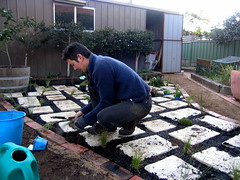
4. Fenceline garden bed with blueberry hedge - this long bed sits partly under a large native conifer that makes the soil acidic and somewhat water repellent, so we built up the bed with compost, manure and mulch, stabilising it with sleepers, and then planted 3 blueberry shrubs so they'll grow into a hedge. Underneath we can grow smaller plants like herbs, lettuces and some crawling vegies such as pumpkins, zucchini, and so on.
Turning this bed into a usable garden space has also opened up the graveled area between it and the paved area, which we can now use for our tai chi exercises! We can also put an outdoor setting here under the pine to make the most of those lazy sunny days in spring and autumn, as well as summer.
It's great to have the time and space to think about how we could make proper use of these spaces in our backyard, so we can get the most out of it depending on what activity we'd like to do in the day, whether it be gardening, tai chi, reading a book in the sun, or treating friends to a barbie lunch!
Sunday 11 May 2008
Pruning and preparing plum trees
As Autumn settles in, we've been doing a bit of clean-up of our vegies and native front garden. In addition, we've been working out preparations for the orchard trees, especially our two Japanese plums, Santa Rosa and Mariposa. I've been sifting through the web and our companion planting book for info on pruning times and procedures and fertilising. There's a mish-mash of info around, so I've attempted to pull some info together as a result. You can also jump into forums like Daly's Fruit Trees for further help from 'experienced others'.
Santa Rosa and Mariposa varieties
These two Japanese varieties are fairly hardy and can grow in most climates, as with the European varieties. They are said to respond well to 'low chill', which makes them ideal for more milder Winters. 'Low chill' means that they can set buds without requiring a long winter chill (European varieties on the other hand need a long chill time to set their buds). In Canberra the frosts provide the chill, but sometimes the winter itself may not be a long one, so we're confident the plums will do well here.
We planted the two plums in June of last year and they had set quite a few buds in the spring the same year, which was a great sign!
The Santa Rosa makes a good pollinator for other varieties especially the blood plums like the Mariposa. It will also self-fertilise to produce a decent crop on its own (according to other sources). Note that European and Japanese varieties will not cross-pollinate, so choose your trees carefully!
Pruning plum trees
Pruning occurs in the Winter, or as the trees lose their leaves. If you have frosty winters like we do in Canberra, then mid-late Autumn to early Winter is a good idea so the wood heals before the hard frosts hit. The idea behind pruning is to reduce the amount of unproductive wood, as the fruit sets along the mature wood. You can prune up to one third of the tree and maintain the tree to a height of around 2.5 metres, making it easier to pick the fruit and protect fruit from birds and possums. Gardening Australia have pruning tips here.
Our trees are only 12 months old, so we may not need to prune one-third, but more likely we can prune any of the early leading branches and laterals, so that the tree takes on a nice shape as it matures and branches don't cross over themselves.
Fertilising plum trees
In terms of stone fruit, Plum trees are probably the most tolerant with clay soils, which makes them more suited to Canberra's environment. To help, you can plant your trees in a raised position to ensure good drainage, or at least add some gypsum to your soil preparation when planting the trees.
An organic all-purpose compost and some blood and bone at budding stage will keep your trees healthy and provide nutrients as the fruit sets. Companion plants such a nasturtiums and lavender will attract bees to help pollinate the buds too. We also apply some sugarcane mulch around the base which provides protection from the frosts and also helps to keep the soil from drying out too much in the summer.
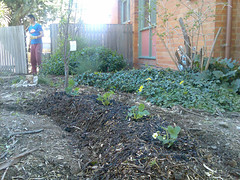 We've also planted some strawberries between the two trees, as they are from the same family. This is said to provide useful information about any moulds or insects around that might negatively affect the trees. A good 'trap crop' in itself.
We've also planted some strawberries between the two trees, as they are from the same family. This is said to provide useful information about any moulds or insects around that might negatively affect the trees. A good 'trap crop' in itself.
You can use a spray of copper oxychloride if your trees do get hit with diseases like shot hole or leaf curl. Don Burke and Gardening Australia have further tips on spraying fruit trees.
So, we're hoping for another healthy show of buds this year, maybe even a couple of fruit too! :o)
Posted by
Marg
at
Sunday, May 11, 2008
0
comments
![]()
Labels: autumn, autumn2008, orchard_trees, plums, pruning
Sunday 9 March 2008
Garden layout and design: some revisions
We posted about our garden design back in early October, adding our new garden beds. From recent posts and photos you can see we're well underway getting the backyard into shape!
 This second diagram shows the worm farm is no longer under the bay tree - Simon moved it under the patio eaves. The worms are going fabulously, so they must like the change! Also, we've potted a lemon tree into a half wine barrel, which is opposite the path from the passionfruit. It's the Meyer variety, said to do well in Canberra.
This second diagram shows the worm farm is no longer under the bay tree - Simon moved it under the patio eaves. The worms are going fabulously, so they must like the change! Also, we've potted a lemon tree into a half wine barrel, which is opposite the path from the passionfruit. It's the Meyer variety, said to do well in Canberra.The area between beds 3/4 and bed 5 is still up for discussion - we're not sure (apart form moving the clothesline, as per dotted black line) as to what we'll do there. We were thinking of using some decking on the ground in a pattern perhaps, but could also plant or add another small bed. Currently it's a combination of (slightly pathetic) grass to the right and gravel on the left. There's paving at the base of the diagram too. We had planned to have no grass, but with recent rains the little patch has come back. We have even contemplated fake turf!
Still, we're looking at an overall "landscaped" (loosely speaking) solution to really turn the space into a user-friendly area. Any ideas welcome!
Posted by
Marg
at
Sunday, March 09, 2008
0
comments
![]()
Labels: decking, design, garden, garden_design, garden_layout, landscaping, projects, turf
Saturday 23 February 2008
Fernery and pond
We bought a tree fern last weekend and have put it near the lattice (I'm sure you can spot it at the back there). This one was harvested from Victoria and is about 2 feet tall (when measuring the core).
I'm wondering if others in Canberra have set up tree ferns too - what success have you had? Have they been fairly self-managing? Do they require a lot of attention in particular? We also bought a native fern (just to the left of the tree fern in the photo here), which is in fact a water fern by name, but said to be a hardy plant.
So, we'll see how our semi-wet/semi-dry fernery goes over the next month as we move into Autumn and Winter.
Summertime: corn and snake beans
Our small lot of corn have taken off with the cobs almost ready to pick. We planted some snake beans beneeath them and they've started climbing over the corn and shooting lovely purple flowers, ready to fruit as well.
Our tomatoes are like a jungle - cherry, roma and everything else in between! There's potato plants among them - if we could only just find them.
And our pièce de résistance has been the fruiting of our old passionfruit vine which covers our back patio frame. Hoorah! Lots of fruit dropping off, presenting themselves graciously to us and they are lush and perfumey to eat too.
A bit of TLC and you really (literally) reap the rewards!




